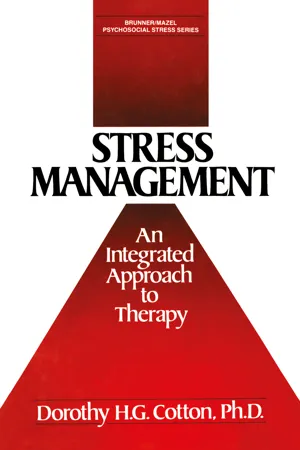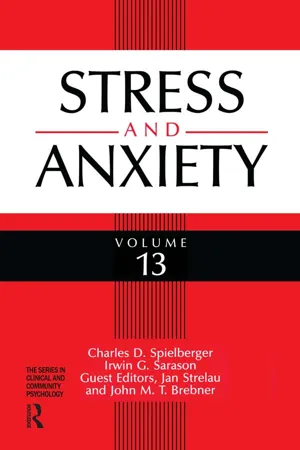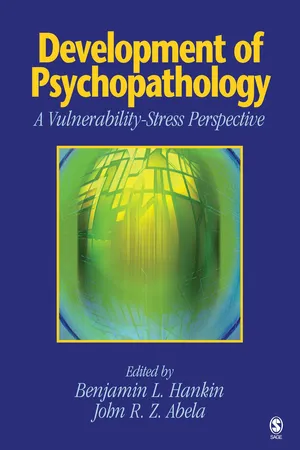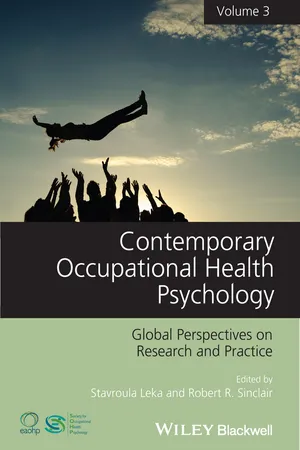Psychology
Measuring Stress
Measuring stress involves assessing the physiological, psychological, and behavioral responses to stressors. Common methods include self-report questionnaires, physiological measures like heart rate and cortisol levels, and behavioral observations. These measures help psychologists understand the impact of stress on individuals and develop effective interventions.
Written by Perlego with AI-assistance
Related key terms
Related key terms
1 of 4
Related key terms
1 of 3
11 Key excerpts on "Measuring Stress"
- eBook - ePub
Stress Management
From Basic Science to Better Practice
- Wolfgang Linden(Author)
- 2004(Publication Date)
- SAGE Publications, Inc(Publisher)
result of the stress process. Because stress responding can occur at behavioral, cognitive, and physiological levels, measures of stress responses at each level would ideally correlate highly with each other, meaning that they would be synchronous. Unfortunately they are often desynchronous, and some observations made in my laboratory and a brief anecdote may serve as illustrations of the relative desynchrony among various stress measures.When exposing individuals to controlled laboratory stressors, we routinely request participants to provide a rating of the stressfulness of the experience, primarily to serve as a validation check. This method has been very effective in showing that a mild stressor like exposure to white noise receives a mean rating of 3 on a 10-point scale whereas an arithmetic challenge with interjected harassing feedback is likely to rate on average of 7 out of 10, thus validating the anticipated differences of the severity of the stressors. However, irrespective of the type of stressor used, and provided that a large sample was tested, some participants rated the exact same stressor 1 out of 10 whereas somebody else rated it 10 out of 10. What accounts for such whopping differences in perception? It is posited that these often greatly varying ratings of the same stimulus reflect a blend of (a) stable, natural response tendencies toward repressing or sensitizing toindividually relevant affective information; (b) the subjective, idiosyncratic meaning of the stressor; (c) possible differences in the ability to perceive simultaneous physiological activation; and (d) possible mood priming via pleasant or unpleasant daily events that preceded participation in the research study. - eBook - ePub
Job Stress
From Theory to Suggestion
- John M Ivancevich, Daniel C Ganster(Authors)
- 2014(Publication Date)
- Routledge(Publisher)
The choice of particular measures, and the method of administration obviously depend on the nature and goals of the specific study. As we have noted, some of the physiological measurement techniques are more appropriate for studies of response to acute stressors and others are more useful in studies of chronic stress. If one is interested in chronic stress then it is necessary to collect repeated measures of stress over time. The timing and frequency of the assessment should depend upon factors such as whether the stressor is continuous, episodic, or cyclic, the occurrence of other predictable sources of stress such as holiday seasons, and whether one wishes to assess changes in stress response associated with changes in environmental sources of stress. For example, in a study of changes in stress associated with a change in work schedule it would be important to assess stress response both before and after the change. Furthermore, measurements taken immediately pre- or post-change may reflect disruption due to the change itself rather than stress responses associated with the two different schedules. Measures taken two or more weeks before and after the change may more accurately reflect differences due to schedule. If one is interested in chronic stress in a relatively static environment several measures taken over a year or more are probably adequate. In our ongoing studies of chronic stress we measure stress two to four times a year.Comparison groups are essential in the interpretation of any of these measures of stress. Although normative data are available for many of the self-report and physiological measures this seldom provides a useful comparison because the "normal" range is often large, and sample idiosyncracies may bias the results. In addition, stress related elevations in somatic and emotional distress, blood pressure, heart rate, the catecholamines, and corticosteroids, and decrements in behavioral performance are generally still within normal ranges. Therefore, it is important to have a comparable comparison group.We have argued that no single measure of stress should be used alone. Rather, measurement of multiple domains is necessary to evaluate the complexities of the stress response. Stress is not a simple stimulus-response reaction, but instead is a process in which a physical or psychological stressor impinges on an individual, appraisals by the individual, and psychological, behavioral and physiological responses of the individual. Understandably, most behavioral researchers have relied primarily on paper and pencil self-report measures assessing only a few of these domains. However, as interest in the health consequences of stress has increased more researchers have incorporated behavioral and physiological measures into their studies. Assessment of these domains of stress response is important if we are to understand the processes linking stress with health consequences. We have discussed the strengths and weaknesses of the four domains of stress measurement, focusing particularly on the biochemical measures likely to be less familiar to behavioral scientists.Stress Related Health Consequences
Most of the measures described above assess aspects of the stress response itself. Many other biological and health consequences of stress can also be measured. Two responses which may reflect physiological changes resulting from the stress response, and which may more directly mediate specific health consequences are cardiovascular reactivity and immune system function. These are both being measured with increasing frequency in studies of stress consequences. - eBook - ePub
Stress Management
An Integrated Approach to Therapy
- Dorothy H.G. Cotton(Author)
- 2013(Publication Date)
- Routledge(Publisher)
4Assessment of Stress: Tools and Methods
By now, it should be obvious that there are three categories of variables which need to be assessed; these are (1) stressors, including major life events, hassles, and appraisals; (2) the stress reaction, including cognitive, behavioral, and physiological responses; and (3) personal characteristics of the client, including personal resources (strengths and weaknesses), behavior patterns, and coping styles. Measurement of these items is carried out for two reasons. First, problematic areas must be defined so that therapy can be planned appropriately. Secondly, the client's initial status must be clearly identified so that progress can be measured over the course of therapy.MEASUREMENT APPROACHES
There are three approaches to measurement that can be utilized for each variable. First, the item in question may be examined in a general interview format. Second, the item may be assessed through use of rating scales, checklists, or other paper-and-pencil measures. Third, the item may be measured (or observed) directly. Each of these general approaches has its own strengths and weaknesses, and each has its own important role to play in the treatment of the individual client.The Interview
It is difficult to conceive of a therapeutic relationship which does not begin with an in-depth interview between client and therapist. As was stated earlier, basic interviewing skills are as important in the management of stress as they are in any other type of therapy. It is not within the scope of this book to teach such interviewing skills. However, it is worth pointing out the strengths and limitations of the interview format.The interview is the basic means of communication between therapist and client. In a semi-structured interview (i.e., an interview following a general format), the client has the opportunity to state his or her problems and interpretations of them, and to make his or her request for help. The therapist may request information about any aspect of the client's problem, and may pursue any line of thought or interest which arises. Thus, the interview is flexible, usually relatively pleasant, responsive to individual needs and personal styles, and as thorough or in-depth as the interviewer and client wish to make it. The interview is the foundation of any therapeutic relationship. No amount of testing, recording, and measuring will compensate for a poor or incomplete interview. It is generally from the initial interview that all other forms of assessment arise. However, the interview is an incomplete assessment tool. Depending upon the orientation of the interviewer and the comfort of the client, major areas of concern may be overlooked or minimized. The interview process also does not yield a measurable record of the client's status at any point in time. It is difficult to assess change by comparing one interview to another. Interviews are also quite time-consuming; it may take a great deal of time to elicit the amount of detail regarding symptoms and history that is necessary to begin therapy and monitor progress. Interviews are particularly susceptible to social desirability and expectancy biases. Thus, essential as it may be, the interview is not a sufficient measure for planning and evaluating therapy. Some of the limitations of the interview may be overcome by using a structured interview format, but at the same time, such a structure reduces the interview's flexibility, one of its major advantages. - eBook - ePub
- Charles D. Spielberger, Irwin G. Sarason, Jan Strelau, John M. Brebner, Charles D. Spielberger, Irwin G. Sarason, Jan Strelau, John M. Brebner(Authors)
- 2014(Publication Date)
- Taylor & Francis(Publisher)
Large group studies are continuing in which we aim to develop further new assessment measures for the validation of the theoretical model of stress. The most relevant scales of PCI (Perceived Dithering in Decision Making and Perceived Concentration and Attention Problems) have now been successfully expanded. Currently we are measuring the extent to which people perceive the nonsatisfaction of their needs. This is seen as important in the generation of stress and psychosomatic illness (Scheuch & Schreinicke, 1983; Vogel, Scheuch, Naumann, & Koch, 1988). On the output side, we are developing assessment instruments for monitoring emotional, cognitive, and work stress responses. Following the development of general assessment scales using large student populations, parallel specific-task versions are being produced for self-assessment on laboratory tests. These instruments are also being cross-validated by application to employees in work situations (nursing and teaching in Scotland and industry in the German Democratic Republic). If our enterprise is successful, then there would be scope for general application in industry and commerce.In regard to the proposed future application of our research, we support the dictum of Kurt Lewin that “there is nothing more practical than a good theory,” but we also believe that, in stress research particularly, “there is nothing more theoretically useful than good practical application.”CONCLUDING COMMENT
This chapter has attempted to demonstrate that it is possible to develop methods of assessment of stress generation and stress response for the purpose of successfully testing an interactional–transactional theory of stress, in which stress is conceived of as an intervening variable in a biocognitive model. For the purpose of validation of the model, the advantages of parallel studies using both self-assessment surveys in large groups and one-subject psychophysiological experiments in the laboratory are indicated.SUMMARY
The concept of stress is presented as a self-inflicted mental state, intervening between stress generation factors and stress responses. Subjective cognitive appraisal of perceived coping incapacity (PCI) is regarded as a primary stress generator. Personality traits and states (e.g., anxiety) are seen as influencing this process. Physiological, emotional, and cognitive stress responses are regarded as interrelated and affecting motivations and behavioral responses. “Stress” is conceptualized as being at the center of a complex in which actual ability, actual demands, PCI, and motivation are influenced by various stress responses and their consequences. An assessment is made of the possibilities for measurement of the relevant factors in stress generation and response. In the research reported in this chapter, psychometric measurement scales were constructed to assess PCI and general motivation and were applied in the prediction of examination performance and psychosomatic ailments. Our Cognitive Appraisal Stress Test (CAST) measure of PCI significantly predicted psychosomatic ailments in university students, and also in university librarians during a high-pressure work period but not during a steady work period. (Stress-related psychosomatic ailments were assessed by a newly developed scale called PSYSOM.) Poor examination performance (essay writing) was significantly predicted by the CAST Perceived Attention and Concentration Problems subscale and also by a low score on the General Motivation Scale (GEMOS) Enterprise: Determination to Take Action subscale. High PCI (CAST) related to low motivation (GEMOS). Psychosomatic and examination performance data were not related. A specific-task version of CAST is now being used in extended one-subject psychophysiological experiments: We are using varied levels of interference during repeated work tasks and repeated self-assessments using CAST. So far high correlations have been obtained between PCI and the measures of heart rate, nonspecific skin conductance response, and the rate of fluctuation in the amplitude of finger pulse volume. The results thus far illustrate the successful testing of a stress model that is still under development. - eBook - ePub
Development of Psychopathology
A Vulnerability-Stress Perspective
- Benjamin L. Hankin, John R. Z. Abela(Authors)
- 2005(Publication Date)
- SAGE Publications, Inc(Publisher)
stress (S. Cohen, Kessler, & Gordon, 1995). Prevailing definitions all focus on environmental circumstances or conditions that threaten, challenge, exceed, or harm the psychological or biological capacities of the individual (S. Cohen et al., 1995). These demands may occur in the form of change in the social environment or in persistent environmental conditions that present ongoing threats and challenges. In this sense, all definitions of stress include an environmental component. Definitions of stress differ, however, in the degree to which they emphasize psychological processes that occur in response to the environment.The most widely accepted definition of stress has been the one offered by Lazarus and Folkman (1984): “Psychological stress involves a particular relationship between the person and the environment that is appraised by the person as taxing or exceeding his or her resources and endangering his or her well being” (p. 19). This definition has been cited frequently as the conceptual basis for research on stress in young people and adults.Although the transactional theory that Lazarus and Folkman (1984) proposed helped to advance the field of psychology and the understanding of stress processes, there are some inherent problems with including appraisal in the definition of stress. First, a definition of stress that relies on cognitive appraisal processes is problematic for research on children and adolescents (Grant et al., 2003). Results of research on stress during infancy indicate there are clear negative effects of maternal separation, abuse, and neglect on infants (e.g., Field, 1995; Perry, Pollard, Blakley, Baker, & Vigilante, 1995). These negative effects occur, presumably, without the cognitive appraisal component that is central to the transactional definition.1 - eBook - ePub
- Maureen Dollard, Helen R. Winefield, Anthony H. Winefield, Maureen Dollard, Helen R. Winefield, Anthony H. Winefield(Authors)
- 2003(Publication Date)
- CRC Press(Publisher)
Porac (1990) argued that whilst the construct validity problem existed with all questionnaire studies it did not make them useless but rather, they required validation against direct nonverbal measures of first-order appraisals (Porac, 1990). Such first-order assessment might entail measuring the arousal component of the first-order affective reaction with the galvanic skin response, or measuring the memory structures activated during an affective state via reaction times.The objective measurement of outcome measures in both the psychological and work environment models would be theoretically consistent. Lazarus and Folkman (1984) explain that there are problems with indexing emotions objectively using physiological indications, such as hormonal or physical responses, or facial responses to certain emotions (Ekman and Friesen, 1975): ‘we are in a sense entrapped by the need to verify one unknown, the experiences of emotion, by reference to other unknowns such as the meaning of the person’s actions in a particular environmental context’ (p. ).Other less problematic objective measures recommended for work stress research include organisational data such as actual days lost to sickness, accidents, health care utilisation costs, actual illness and physiological measures, including, diastolic and systolic blood pressure, heart rate, skin temperature, and stress hormones, i.e. adrenalin and cortisol (Schaubroeck and Ganster, 1993).3.3.3 Summary
In summary, it may not be appropriate in psychological theoretical paradigms to measure objective job characteristics because the researcher is interested in the perception or appraisal of the environment, and in such cases self-report may be a valid and useful source of information.When objective information is considered ideal, as in work environment models it is important to ascertain the approximation of self-report to objective assessments. Despite the shortcomings of the self-report method, empirical evidence has provided support for the accuracy of self-report measures (whether or not aggregated) of the objective environment. While some concerns have been raised about the influence of irrelevant cues on perception, these do not appear to rule out the potential influence of objective characteristics of the job. - Kent Norman, Jurek Kirakowski, Kent Norman, Jurek Kirakowski(Authors)
- 2017(Publication Date)
- Wiley-Blackwell(Publisher)
As the study of task load and stress matures, the use of both constrained, laboratory‐style tasks and more realistic tasks within the same protocol and participant cohort can be expected. Although this will likely involve participants completing different types of tasks, which raises questions about whether any single measurement approach could be consistently applied across the tasks, it is needed to answer questions of how well the findings from the literature on laboratory‐style tasks will generalize to more realistic task conditions, and whether laboratory‐style tasks can be used to calibrate task load measurement systems for those conditions. Since task load and stress are only probabilistically linked to measures of these effects, it is desirable to record as many measures as possible (Larsen & Fredrickson, 1999), and indeed this is a trend in multimodal HCI.Measures of Task Load and Stress
Arguably the concepts of task load and stress have little relevance to practical HCI systems unless they can be measured. However, in order to be useful, task‐load measures should ideally be sensitive to task demand, specific to the type of task demand dimension being investigated, help to isolate the origins of the task demand, and not obstruct the performance of the user’s task, and maintain these attributes consistently over time (O’Donnell & Eggemeier, 1986) and across different measurement contexts (Kramer, 1991). In surveying the current status and limitations of existing methods for task load and stress measurement, for many it may be more correct to say that they are estimating rather than measuring task load. Among the different categories discussed below, it is interesting to note that only one (analytical) is directly related to the intrinsic level of task demand; all other measures relate to the effect of the task on the user (Young et al., 2015). Also, only three (physiological, behavioral, and to some extent performance) can be completely automated.Analytical
For a limited range of very specific kinds of tasks, it may be possible to determine a priori what the intrinsic load of a task is. Methods have been proposed for decomposing and characterizing arithmetic tasks by analyzing them for example in terms of element interactivity (Sweller, 1994), similarly to the manner in which the complexity of computing algorithms may be analyzed.- eBook - ePub
Teacher Well-Being
Looking After Yourself and Your Career in the Classroom
- Elizabeth Holmes(Author)
- 2005(Publication Date)
- Routledge(Publisher)
Teacher Support Network runs a fully interactive online multiple-choice assessment of teacher stress. It covers symptoms and signs, work and life events and pressures, and well-being and lifestyle. You can submit your responses online and receive an immediate automatically generated report.Although this is not intended to provide a comprehensive and systematic personal stress audit, both the process of completing the questionnaire and the report that follows will give you a clear idea of the impact that negative stress is having on your life at the moment.There is a link to the stress assessment from the homepage of the Teacher Support Network website: http://www.teachersupport.info/Types of stress
Several thinkers on stress and stress management have categorised the concept of stress, splitting it typically as follows:- Stress resulting from anticipation: fear of what’s to come, worry and anxiety.
- Stress as a response to a current situation: it’s happening now, and you have to react.
- Stress from the past: it happened a while ago, but is still large in your mind and seemingly impossible to let go.
- Chronic stress: it’s an on-going situation, or reaction to a specific event, the impact of which is lingering.
Which type from the list above would you say you suffer from most?ACTION Are you able to identify different types of stress in your life?The physiological stress response
Stress leads to physiological responses in your body. These responses are clear evidence that your body is seeking to maintain homeostasis (or equilibrium), and without them your body would have no mechanisms with which to counteract the varying degrees of stress that each day throws at it. What we sometimes interpret as an alarming symptom needing to be quieted at all costs is in fact a welcome indicator that your body has recognised that it needs to prepare itself for challenges ahead.If your body is successful in its quest for balance, it will have maintained normal levels of internal temperature, pressure and chemistry. However, if the stress facing your body is perceived to be long-standing or extreme, for example, it will kick-start a selection of internal changes known as general adaptation syndrome (GAS), - eBook - ePub
The Psychology of Anxiety
Second Edition
- Eugene E. Levitt(Author)
- 2015(Publication Date)
- Routledge(Publisher)
The fact that there are many different methods of monitoring the occlusion of blood supply when employing a cuff to determine blood pressure is in itself indicative of the difficulty in obtaining accurate and artifact free determinations (Lywood, 1967, p. 156).Some major shifts of emphasis in the study of somatic reactivity have occurred during the past decade … it has been suggested that four problems have emerged in response to these changes. They are: the problem of response definition; the problem of relating response and levels; the problem of units of measurement; and the problem of estimating change (Martin, 1973, p. 328).Add that physiological research requires apparatus that is not infrequently complex and expensive, requiring not only extra funding of the research but additional expertise by the experimenter. Finally, add that being attached to an unfamiliar apparatus may be in itself a stressful experience to the subject, an untoward circumstance that can obtund experimental measurement. [Occasionally, the subject’s apprehension may have some foundation in fact. Venables and Martin (1967b) discuss the unusual situation in the measurement of skin resistance in which the subject may experience pain and even death!]All told, Hodges’ finding (1976) that only 7% of experimental investigations of state anxiety used physiological reaction as a major measurement is not at all surprising. For the same reasons that have caused that minority, the remainder of this chapter deals with psychological measurement. The student who wishes to look further into physiological measurement will find some additional information in Chapter 6 and a great deal more in Venables and Martin (1967a), Martin (1973), and Lader (1975).Projective TechniquesThe most important instruments used by the psychologist in clinical evaluation are projective techniques. Briefly, these are devices in which unstructured or partly structured stimuli are presented to the patient; he must add structure in order to respond, thereby revealing aspects of his personality. The best known projective technique is the Rorschach ink-blot test. There are any number of ways in which to analyze an individual’s response to the 10 ink-blots that make up the test. Some of these ways of analyzing responses are generally considered to yield indexes of anxiety. - eBook - ePub
Contemporary Occupational Health Psychology, Volume 3
Global Perspectives on Research and Practice
- Stavroula Leka, Robert R. Sinclair, Stavroula Leka, Robert R. Sinclair(Authors)
- 2014(Publication Date)
- Wiley-Blackwell(Publisher)
Transactional models describe the process of how individuals uniquely respond to a given potential stressor based on their cognitive appraisal of the stressor (Lazarus & Folkman, 1984). Whereas positive/benign or irrelevant appraisals do not result in the experience of stress (and trigger the secondary appraisal or coping process), harm/loss, threat, and challenge appraisals do initiate further analysis of the situation to determine how best to proceed. According to Lazarus (1999), emotional reactions to a stressor and cognitive appraisals are interrelated, in which case cognitive appraisal represents the interpretation of the event and determines the ultimate emotional outcome. Further, studies of physiological reactivity have demonstrated clear patterns of association with cognitive appraisals (e.g., Tomaka, Blascovich, Kelsey & Leitten, 1993). Yet, Houston (1992) argued that cognitive appraisal provides only a distal influence on physiological reactivity, whereas affective and motivational responses serve as more proximal determinants of cardiovascular reactions to stress. Thus, while psychological reactivity is a related but distinct process from cognitive appraisal, it can be easily incorporated into the transactional model of stress and coping, given that the model specifies individual differences in how people typically respond to stressors as well as situational differences in how one responds from day to day.How Is Psychological Reactivity Measured?
In order to best capture the within-person processes inherent in psychological reactivity, it is necessary to measure stressors (or positive events) and emotional experiences repeatedly over time. Thus, researchers interested in reactivity have often employed daily process (diary) or experience sampling methodologies to assess the extent to which individuals experience different degrees of emotional reaction to events (e.g., Bolger, DeLongis, Kessler & Schilling, 1989; Marco & Suls, 1993). Specifically, daily process methodology involves time-intensive investigations in which individuals record their experiences, thoughts, moods, and behaviors (depending on study purposes) daily or multiple times per day for periods ranging from short periods (e.g., 48 hours) to several months. Such repeated observations allow for the assessment of typical patterns of response to stressors, as well as differences between individuals in their responses. Further, given that mood states are dynamic and changeable (e.g., Larsen & Kasimatis, 1990), it is crucial to capture changes in mood close to the time at which they occur, as opposed to retrospectively (e.g., Tennen, Affleck, Armeli & Carney, 2000). That is, longer-term recall of mood is influenced by recall bias (e.g., Bolger, DeLongis, Kessler & Schilling, 1989), and furthermore, people are unable to recall contingencies in emotional reactions or behaviors, which are the subjects of interest to reactivity researchers. As with other repeated measures studies, each person acts as his/her own control, such that each person’s natural baseline (i.e., his/her general level of stress/negative affect) is factored into the study (with person-centered data). Furthermore, depending on the design of the diary study, it is possible to assess delayed (i.e., lagged) emotional reactions to stressors. As an example, Mohr et al. - eBook - ePub
Coping with Stress at University
A Survival Guide
- Stephen Palmer, Angela Puri(Authors)
- 2006(Publication Date)
- SAGE Publications Ltd(Publisher)
Part 1 What is stress? Although you may hear the word ‘stress’ used all the time, if you were asked to explain what stress actually means, you may find that it is a harder question to answer than you originally thought!This section of the handbook explores the different interpretations of the word ‘stress’ and how your own perception of the world around you influences your definition of the term. In addition, the body’s reaction to stress is also discussed in detail (the stress response) and you have the opportunity to fill in a questionnaire to identify how your own body reacts in stressful situations.As the perception of what is stressful differs from person to person, Part 1 of the handbook gives you an insight into your own stress levels. There are questionnaires which allow you to identify how you handle your day-to-day problems (The Life Stress questionnaire), what your personality type is (Type A or Type B questionnaire) and the views you hold about the world around you and the amount of control you believe you have over circumstances and events which occur in your life (Locus of Control questionnaire).By the time you have completed Part 1 of the handbook, you will have a greater awareness of what situations in your life may cause you stress and you will also be able to identify how stress impacts on your psychological and physical well-being.Passage contains an image
1
Understanding stress
What this chapter covers
In this introductory chapter, we define what is meant by the word ‘stress’ and why it is a term that is so hard to conceptualise. The chapter looks at how stress affects your health and explains the long-term repercussions of ignoring the warning signs your body provides when you are stressed. There is also an exercise at the end of the chapter for you to identify how you react when you are feeling the pressure
Index pages curate the most relevant extracts from our library of academic textbooks. They’ve been created using an in-house natural language model (NLM), each adding context and meaning to key research topics.
Explore more topic indexes
Explore more topic indexes
1 of 6
Explore more topic indexes
1 of 4










